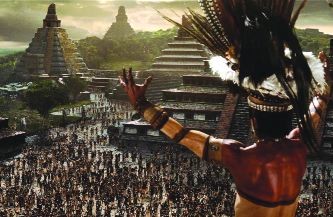Fall of the empire

The Mayan Empire existed for 4,000 years, from 2500 BC to 1500 AD, and it spanned five modern-day countries—Mexico, El Salvador, Honduras, Guatemala and Belize. Mayan civilization made significant strides in astronomy, agriculture and architecture, and it prided itself on its colorful art and skilled artisans. By the end of their reign, however, the Mayans turned to self-destructive money-hoarding, power-grabbing and environment abuse.
Apocalypto, directed and co-written by Mel Gibson, focuses on the last days of the Mayans, when famine and disease wiped out huge numbers and a desperate search for survival and immortality led people to horrific acts that guaranteed their doom.
The epic tale centers on a small tribe of hunters living in the rain forest, far from the major Mayan cities which are descending into chaos. The hunters’ lives seem idyllic. As the men go out hunting each day, joking among themselves and basking in the warm glow of their families, they do not suspect that disaster looms. It arrives in the guise of a different “hunting party,” looking for a more complex kind of prey.
The central character is Jaguar Paw (Rudy Youngblood), the son of the village leader, who somehow manages to hide his pregnant wife and young son before he is taken away in chains, along with the other villagers. It is during this death march through the jungle that we get to know Jaguar Paw’s main antagonists: the proud and violent Zero Wolf (Raoul Trujillo), who is intent on proving his leadership over the younger warriors, and the sadistic Snake Ink (Rodolfo Palacios), an impatient second-in-command who would love nothing more than to kill Jaguar Paw.
The film, which Gibson co-scripted with Iranian-born Farhad Safinia, is structurally simple but dramatically sound. After the expository opening, in which viewers meet the villagers and witness the attack, the film takes us on the captives’ long march through the jungle, where they encounter matters spiritual and supernatural, including a young girl with smallpox who foretells, like a crazed sibyl, the ultimate doom of one of the mocking warriors. The journey is followed by one of the longest and most fascinating chase sequences I’ve ever seen, as Jaguar Paw tries to get home to save his wife and child.
Gibson has massaged the material to make a broader statement about what happens to civilizations as they get bloated, corrupt and cruel. He focuses on how the most powerful—including the religious leaders—start to abuse their lofty positions, and on the price that the common person pays. It’s not a leap to conclude that Gibson is suggesting that the U.S. is on such a path, especially in the way it sacrifices young men and women in distant wars to reassert its lofty position on the world stage.
But Gibson is far too savvy and commercial a filmmaker to rely on symbolism and metaphor alone to carry his film past the two-hour mark. Instead, he has crafted a rousing action-adventure film that barely pauses to catch its breath.
The story and theme are a perfect fit for Gibson’s strengths as a filmmaker. As usual, he preaches that humankind must suffer before attaining grace. But unlike The Passion of the Christ, in which Gibson wallowed in the pain and agony, Apocalypto allows the tale to drive the message.
The film plays out in the Yucatec language, a Mayan dialect that is rarely spoken anymore. Though Gibson provides subtitles, his images are so vivid and clear I found myself wondering how it might have played without any subtitles. The ambiguities of meaning might have added to the drama.
The cast is a potent mix of professionals and first-timers. The costumes and production design are first-rate. And the cinematographer, Dean Semler (Dances with Wolves), employs high-end digital technology that permits him to shoot in the dimly lit jungle using only natural light, which gives the entire production a painterly glow. The film is extremely violent, with all sorts of gruesome killings, brutal sacrifices, bouncing heads and even a beating heart or two getting ripped out of a bloody chest. (It earns its R-rating, and then some.)
As Gibson tries to recover from the publicity surrounding his drunken anti-Semitic rant, he has come up with one of the most significant and politically relevant movies in years. Who would have guessed?




